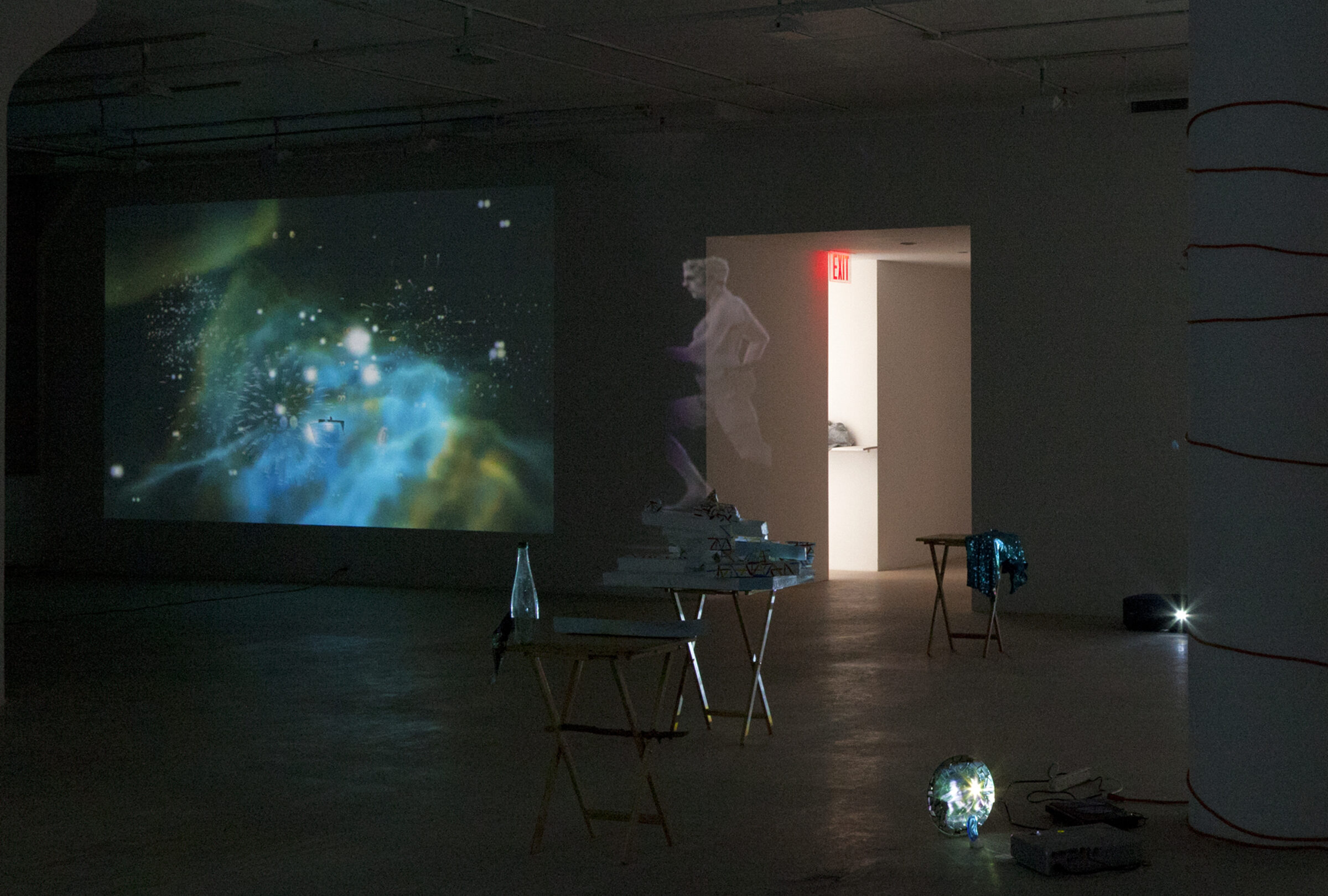Greene Naftali
Exhibition
Trisha Baga
The Biggest Circle
Greene Naftali, New York
Press Release
Download PDF

Greene Naftali is pleased to announce The Biggest Circle, an exhibition of new work by New York-based artist Trisha Baga. This will be the artist’s first solo show at the gallery. This exhibition coincides with Baga’s Plymouth Rock 2, a solo exhibition in the lobby gallery of the Whitney Museum of American Art, and her participation in the MoMA PS1 group show, New Pictures of Common Objects.
Trisha Baga’s abundant video installations flow between the moving image, distinct three-dimensionality, and a flirtation with the history of two-dimensional practice. Projecting digital video of pop culture scenes and original footage across installations of found and constructed objects, Baga creates immersive environments in which the tangible and the virtual each have an insistent presence. Moreover, a fresh angle on performance plays an important role in her exhibitions – Baga has performed at EAI and PS1 in New York, The Cornerhouse in Manchester, and Johann Koenig in Berlin. Whether through performance or through insights to her practice captured on video, the artist makes unassuming appearances in many of her pieces.
For this exhibition, Baga has turned the gallery space into a grand theatre of imagery, sound, and objects. Five discrete videos and video installations show an exploration of the capacity of narrative, and a sensibility dangling between the poetic and the comedic. Scattered throughout the gallery space, and selectively obscuring the video works, are a collection of slight, mundane objects – empty water bottles, utilitarian folding tables, bits of Styrofoam. The artist opens the show with “Bag’s Circle,” in which a painted bag, drifting in and out of visibility, rotates along the gallery walls, while vibrant paintings and tropical trees act as varying locators. “Bag’s Circle” is at once expansive and compressed, splendid and uncanny. As the viewer moves through Baga’s installations, boundaries between space, viewer, and artwork dissolve in a way that is at once disconcerting and an opportunity for new possibilities.
Baga’s most narrative piece in the exhibition, “Hercules,” employs 3-D effects with simultaneous proficiency and playfulness. In the video, Madonna channels a commentator on the London Olympic Games, a teenage kid indulges his love of fireworks in footage appropriated from Youtube, a karaoke version of a Nicki Minaj’s Starships plays, and costumed Pilgrims chase chickens at the campy and questionable landmark Plymouth Plantation. All of these elements are captured and expertly intertwined to create ecstatic sequences punctuated by meditative intervals. The video unravels much in the structure of a dream. Identities slide, the familiar and the impossible coincide, and incongruities abound. Baga’s anchoring motifs of a computer rendered flame, an animation of a canoeing couple, a cut out of a cloud, serve to evoke the elements and underline the expanse of Baga’s subject matter.
In “The Story of Painting,” Baga exhibits a slide show of painted and found elements to the soundtrack of a lecture by Sister Wendy, a self taught art historian, whose delighted recounting of Impressionism and Post-Impressionism is distinguished by her inclination towards quirky details. Sister Wendy describes a “fat lady in a tarty boudoir,” and relates an Impressionist painter’s “great eye for the ladies.” In the piece, Sister Wendy’s talk synchronizes with the video at chance points. The space between this discrepancy of sound and image serves as a territory in which the viewer can reframe what she is seeing. Baga closes the installation with an intimate piece, “Studio Photographs 2012,” a casual experimentation with photography and light. Nestled into the corner of the back gallery, the piece, projected onto a canvas prepared with glow-in-the-dark paint, displays a shadow of the Baga’s hand and spotlighted photos of a haphazard studio and the artist’s dog. Baga fastens the show with a playful indication of an artist in practice.
Trisha Baga has presented work at The Whitney Museum of American Art, Dundee Contemporary Arts, Greene Naftali Gallery, Vilma Gold Gallery, MoMA PS1, LAXART, and EAI.


